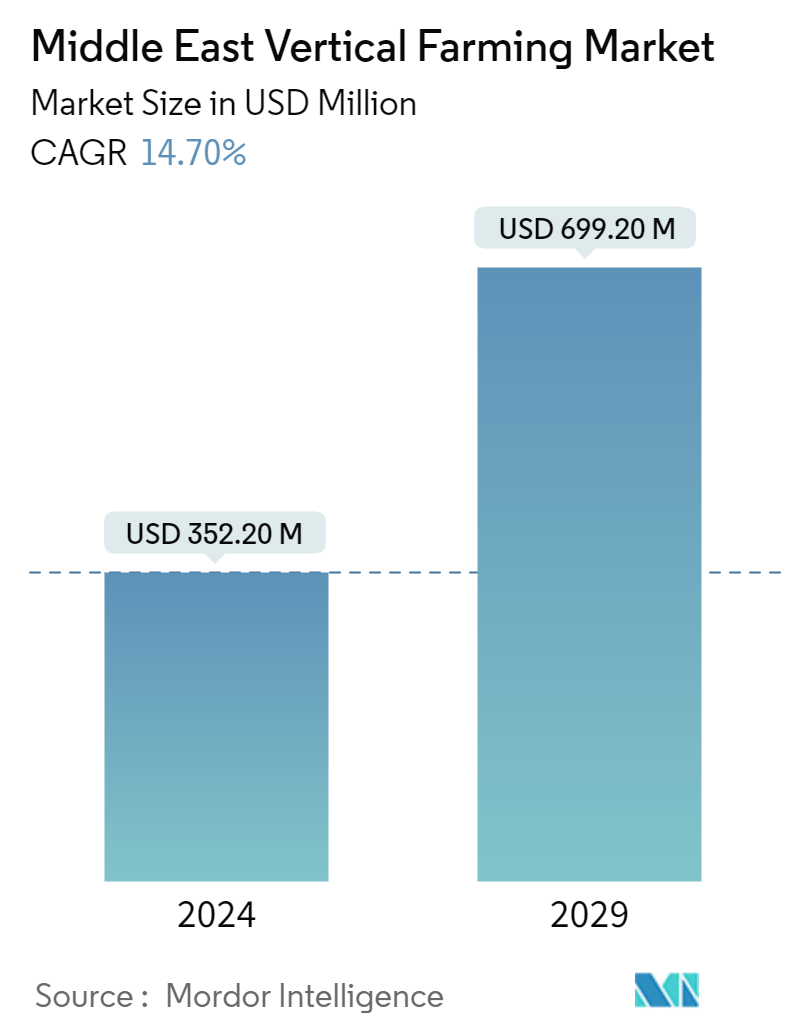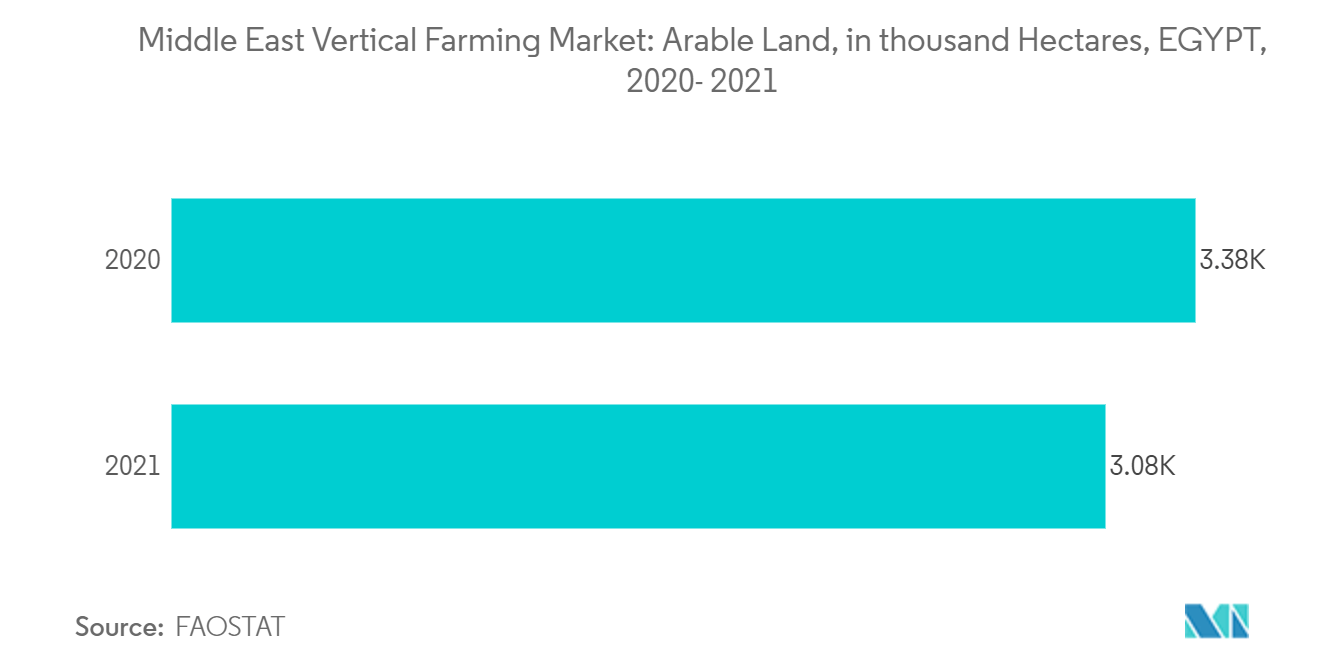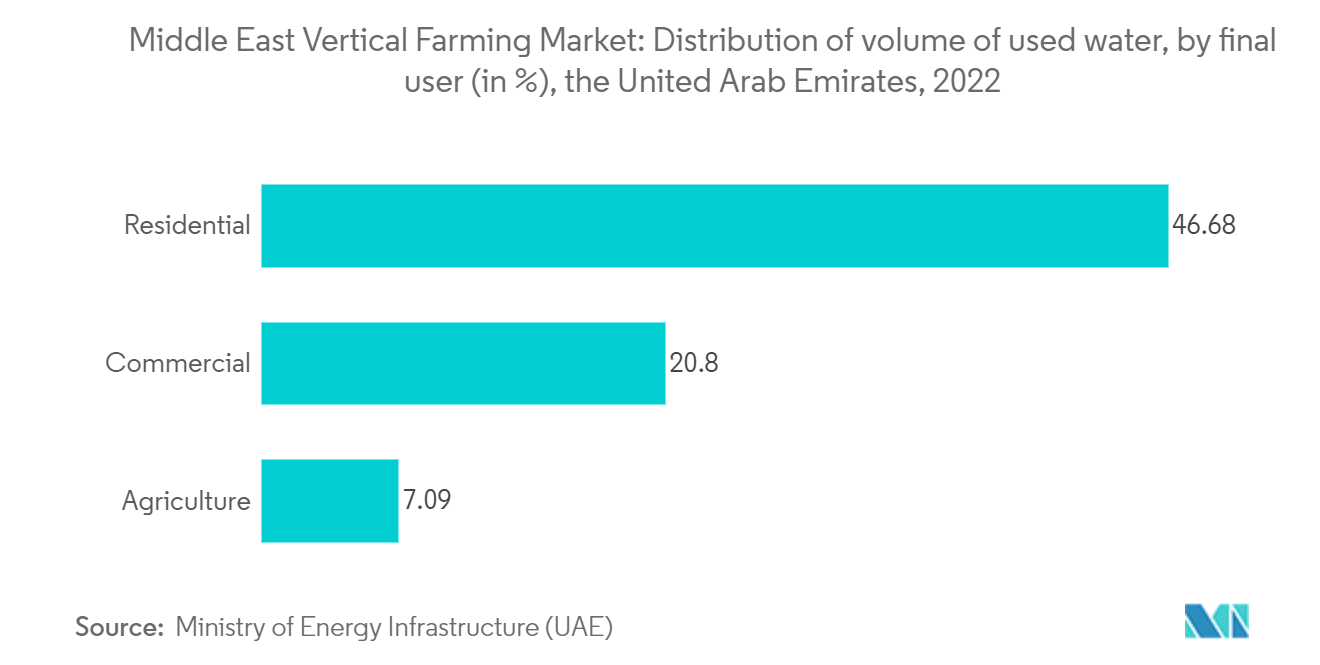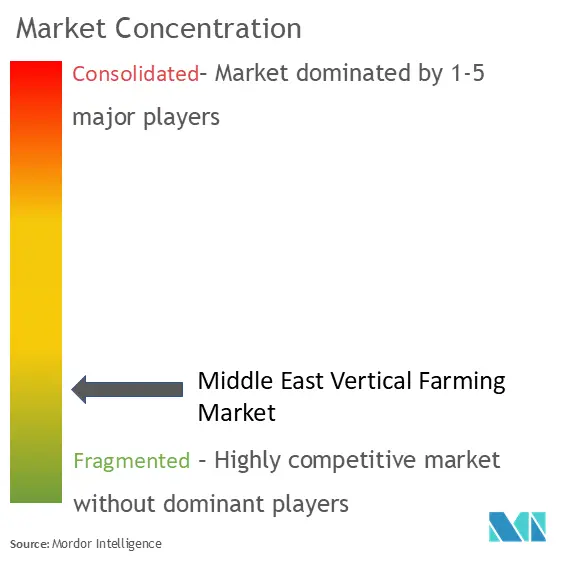Middle East Vertical Farming Market Size

| Study Period | 2019 - 2029 |
| Base Year For Estimation | 2023 |
| Market Size (2024) | USD 352.20 Million |
| Market Size (2029) | USD 699.20 Million |
| CAGR (2024 - 2029) | 14.70 % |
| Market Concentration | Low |
Major Players.webp)
*Disclaimer: Major Players sorted in no particular order |
Middle East Vertical Farming Market Analysis
The Middle East Vertical Farming Market size is estimated at USD 352.20 million in 2024, and is expected to reach USD 699.20 million by 2029, growing at a CAGR of 14.70% during the forecast period (2024-2029).
The Middle Eastern region is highly suitable for developing vertical farms due to water scarcity, less arable land, and higher dependency on imports for food requirements. Factors like increased investments in food security, the use of vertical farming in production and delivery, and public-private sector collaborations contribute to market growth. Moreover, companies are focusing on various strategic activities, including partnerships, mergers, and acquisitions, to strengthen their market presence. For instance, in 2023, Saudi Arabia’s Public Investment Fund (PIF) signed a joint venture agreement with AeroFarms, a US-based sustainable agriculture company, to build indoor vertical farms across the Middle Eastern region. The first farm to be built in Saudi Arabia is expected to have an annual production capacity of up to 1.1 million kgs of crops with the country’s USD 620 billion PIF. Furthermore, other players are focused on developing vertical farms in the region. For instance, in July 2022, Crop One Holdings and Emirates Flight Catering opened the world’s largest vertical farm. It is a 330,000-square-foot facility near Al Maktoum International Airport at Dubai World Central. It can produce over 2 million pounds of leafy greens annually.
Middle East Vertical Farming Market Trends
Hydroponics Is The Preferred Technique For Vertical Farming
Hydroponics is ideal for crop production in arid countries, such as the United Arab Emirates, Qatar, and the Kingdom of Saudi Arabia, where there is low availability of arable land. It significantly reduces water consumption within a less agricultural area. Subsequently, vertical farms that adopt hydroponics technology are on the rise across the countries in the region, clearly showcasing the growth potential of the segment in the market. Moreover, the region beholds the production of rare and expensive crops in the hydroponics system. With light-assisted hydroponics systems, farmers not just effortlessly grow mass-consumed food crops but also rare and exotic plants and foods of high value, which drives the adoption of the technology. For instance, Sharjah-based agricultural technology company Veggitech cultivated and harvested the world’s most expensive spice, saffron, also known as red gold. After a few years of experiments with smaller quantities of saffron bulbs, the teams at Veggitech cultivated roughly 150,000 crocus Sativa bulbs by growing them in vertical farms in Al Zubair in 2022.

Vertical Farming Is Widely Adopted In The United Arab Emirates
The UAE economy is diverse, with consumers having a high standard of living. Despite the environmental challenges in producing agricultural commodities, the country has made tremendous efforts over the last decade by adopting sustainable and smart agriculture techniques, such as hydroponics, smart irrigation, and aquaponics. Thus, the optimum utilization of arable land and the quality of local fresh produce improved.
Vertical hydroponics is gaining popularity among farmers in the United Arab Emirates, especially for growing local fruits and vegetables with minimal water resources. Due to low domestic production, the country heavily depends on imports to cater to its local demand for fresh fruits and vegetables. The arid climate and scarcity of water force growers to rely on other water resources, such as seawater desalination, for agricultural production, which favors market growth.
Companies are shifting their activities in the United Arab Emirates due to cheaper electricity prices, which is essential for their operations and eager investors. The lower electricity prices are being provided as part of the initiative by the United Arab Emirates to strengthen local production capabilities, with Abu Dhabi introducing its own Abu Dhabi Industrial Strategy to encourage domestic manufacturing in line with the country's goals.

Middle East Vertical Farming Industry Overview
The vertical farming market in the Middle East is fragmented. Aerofarms, Pure Harvest Smart Farm, Crop One Holdings, Kalera Farms, and Mowreq are some of the major players operating in the market. The players are investing in product improvisation for business expansions. They have also been expanding their business by adopting various strategies such as acquisitions and partnerships.
Middle East Vertical Farming Market Leaders
-
Aero Farms
-
Crop One Holdings Inc.
-
Kalera Farms
-
Pure Harvest Smart Farm
-
Mowreq
*Disclaimer: Major Players sorted in no particular order

Middle East Vertical Farming Market News
- December 2023: Pure Harvest Smart Farms acquired RedSea, a Saudi Arabian player that deals with climate-smart technology solutions. According to the acquisition terms, Pure Harvest took over RedSea’s existing six-hectare controlled-environment agriculture (CEA) production facility near Riyadh, Saudi Arabia. Through this acquisition, the company aimed to increase its production of fresh produce in the Saudi Arabian market.
- September 2023: Pure Harvest Smart Farms partnered with Richel Group (Richel), one of the leading organizations providing turnkey, mid- to high-tech greenhouse solutions worldwide. With the main focus on the Middle East and Asia, the partnership aimed to deploy over USD 150 million worth of smart growing systems promoting the production of fresh produce with the flexibility to expand the partnership into new markets of different geographies.
- March 2023: AeroFarms expanded its indoor vertical farming ventures in Saudi Arabia, the United Arab Emirates, and Qatar. The company signed a joint venture agreement with the Public Investment Fund of Saudi Arabia and established a vertical farm producing 1,100 metric tons of crops annually.
Middle East Vertical Farming Market Report - Table of Contents
1. INTRODUCTION
- 1.1 Study Assumptions and Market Definition
- 1.2 Scope of the Study
2. RESEARCH METHODOLOGY
3. EXECUTIVE SUMMARY
4. MARKET DYNAMICS
- 4.1 Market Overview
-
4.2 Market Drivers
- 4.2.1 Increased Focus on Food Security by GCC Countries
- 4.2.2 Low Precipitation and Shrinking Area of Arable Land
-
4.3 Market Restraints
- 4.3.1 High Operational Costs
- 4.3.2 Decreasing Fresh Water Available and Increasing Salinity
-
4.4 Industry Attractiveness - Porter's Five Forces Analysis
- 4.4.1 Threat of New Entrants
- 4.4.2 Bargaining Power of Buyers/Consumers
- 4.4.3 Bargaining Power of Suppliers
- 4.4.4 Threat of Substitute Products
- 4.4.5 Intensity of Competitive Rivalry
5. MARKET SEGMENTATION
-
5.1 Growth Mechanism
- 5.1.1 Aeroponics
- 5.1.2 Hydroponics
- 5.1.3 Aquaponics
-
5.2 Structure
- 5.2.1 Building-based Vertical Farms
- 5.2.2 Shipping Container Vertical Farms
-
5.3 Crop Type
- 5.3.1 Fruits and Vegetables
- 5.3.2 Herbs and Micro-greens
- 5.3.3 Flowers and Ornamentals
- 5.3.4 Other Crop Types
-
5.4 Geography
- 5.4.1 Saudi Arabia
- 5.4.2 United Arab Emirates
- 5.4.3 Egypt
- 5.4.4 Rest of Middle East
6. COMPETITIVE LANDSCAPE
- 6.1 Most Adopted Strategies
- 6.2 Market Share Analysis
-
6.3 Company Profiles
- 6.3.1 Aero Farms
- 6.3.2 Madar Farms
- 6.3.3 Crop One Holdings Inc.
- 6.3.4 Kalera Farms Inc.
- 6.3.5 Pure Harvest Smart Farms
- 6.3.6 Armela Farms LLC
- 6.3.7 Mowreq
- *List Not Exhaustive
7. MARKET OPPORTUNITIES AND FUTURE TRENDS
** Subject To AvailablityMiddle East Vertical Farming Industry Segmentation
Vertical farming, an innovative agricultural approach, cultivates crops in vertically stacked layers. This method employs soil-less techniques like aquaponics, hydroponics, and aeroponics, all within a meticulously controlled environment.
The Middle East vertical farming market is segmented by growth mechanism (aeroponics, hydroponics, and aquaponics), structure (building-based vertical farms and shipping container vertical farms), crop type (fruits and vegetables, herbs and micro-greens, flowers and ornamentals, and other crop types), and geography (Saudi Arabia, United Arab Emirates, Egypt, and Rest of Middle East).
The report offers market sizing and forecasts in value (USD) for all the above segments.
| Growth Mechanism | Aeroponics |
| Hydroponics | |
| Aquaponics | |
| Structure | Building-based Vertical Farms |
| Shipping Container Vertical Farms | |
| Crop Type | Fruits and Vegetables |
| Herbs and Micro-greens | |
| Flowers and Ornamentals | |
| Other Crop Types | |
| Geography | Saudi Arabia |
| United Arab Emirates | |
| Egypt | |
| Rest of Middle East |
Middle East Vertical Farming Market Research FAQs
How big is the Middle East Vertical Farming Market?
The Middle East Vertical Farming Market size is expected to reach USD 352.20 million in 2024 and grow at a CAGR of 14.70% to reach USD 699.20 million by 2029.
What is the current Middle East Vertical Farming Market size?
In 2024, the Middle East Vertical Farming Market size is expected to reach USD 352.20 million.
Who are the key players in Middle East Vertical Farming Market?
Aero Farms, Crop One Holdings Inc., Kalera Farms, Pure Harvest Smart Farm and Mowreq are the major companies operating in the Middle East Vertical Farming Market.
What years does this Middle East Vertical Farming Market cover, and what was the market size in 2023?
In 2023, the Middle East Vertical Farming Market size was estimated at USD 300.43 million. The report covers the Middle East Vertical Farming Market historical market size for years: 2019, 2020, 2021, 2022 and 2023. The report also forecasts the Middle East Vertical Farming Market size for years: 2024, 2025, 2026, 2027, 2028 and 2029.
Middle East Vertical Farming Industry Report
Statistics for the 2024 Middle East Vertical Farming market share, size and revenue growth rate, created by Mordor Intelligence™ Industry Reports. Middle East Vertical Farming analysis includes a market forecast outlook to 2029 and historical overview. Get a sample of this industry analysis as a free report PDF download.



